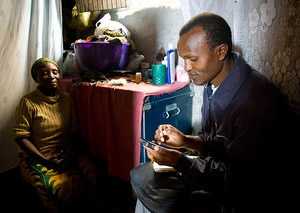Developing Surveillance and Health Information Systems
CDC-Kenya supports the development and implementation of population and facility-based disease surveillance systems that provide for data collection, analysis, and reporting in order to assess the disease burden in communities, identify outbreaks, and evaluate the impact of health interventions. CDC-Kenya has also spearheaded state-of-the-art and mobile data collection systems.

Community interviewer Robert Mutinda interviews Kibera resident. Using a personal digital assistant provided by the CDC, he and 26 other interviewers follow up regularly with Kibera residents to gather information on their health problems. © David Synder
Advanced methods of tracking disease enable public health officials to not only assess disease burden but also identify disease outbreaks in their early stages and evaluate a health intervention’s impact in communities. Recently the Kenya Medical Research Institute (KEMRI)/CDC Health and Demographic Surveillance System (HDSS) has been expanded to support research on the interaction between animal and human diseases. Mobile phone and SMS technology are used to rapidly report animal illness and death from enrolled rural homesteads in western Kenya.
Facility-based surveillance systems provide important information for addressing public health concerns. CDC-Kenya has supported the Kenyan Ministry of Health to establish sentinel influenza surveillance that allow Kenya public health officials to detect new influenza strains in hospitalized patients, to monitor risk factors for severe disease associated with influenza virus infections, and to evaluate new diagnostic, treatment, and prevention strategies. CDC is also investigating the burden of hospital-associated infections, implementing an innovative approach to collecting data using a paperless system of reporting disease in three hospitals using netbooks.
CDC-Kenya’s surveillance activities support decision-making to address the needs of those who are most vulnerable to disease. CDC-Kenya has established surveillance projects in refugee camps in Kenya, Ethiopia, and Tanzania to identify the origin and burden of respiratory diseases. To guide programs and best allocate resources to support populations most at risk for acquiring HIV, CDC-Kenya collects novel data on the size of populations of men who have sex with men, female sex workers, and intravenous drug users.
One of the most significant examples of CDC’s work to build sustainable public health infrastructure, strengthen health systems, and use data to affect policy has been the support to the government of Kenya in implementing national level surveys. The Kenya AIDS Indicator Survey (KAIS) – the most comprehensive Kenyan national surveillance effort to date - represents a significant milestone for Kenya in strategically targeting HIV resources and programs for maximum disease impact. As a result of 2007 KAIS findings, the government of Kenya changed strategies and policies that increased accessibility to HIV testing and better targeted prevention services resulting in fewer new cases of HIV and other sexually transmitted infections. With the second Kenya AIDS Indicator Survey (KAIS) in 2012, CDC and the government of Kenya will again gather comprehensive data to understand the magnitude and distribution of HIV/AIDS and related behavioral risk factors and how the epidemic has changed from 2007. New findings from KAIS 2012 will provide valuable data for program planning and evaluation of HIV infection in Kenya nationwide.
- Page last reviewed: November 16, 2012
- Page last updated: November 16, 2012
- Content source:
Global Health
Notice: Linking to a non-federal site does not constitute an endorsement by HHS, CDC or any of its employees of the sponsors or the information and products presented on the site.


 ShareCompartir
ShareCompartir